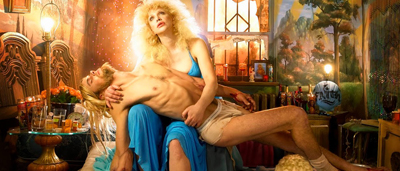David LaChapelle is well known for his career as a contemporary photographer, fine art enthusiast and also, for his involvement with video. After initially gaining his social reputation and position within the artistic community, LaChapelle’s work became noticed by huge artistic figures. Andy Warhol spotted his artistic creations and offered him his first job, at Interview magazine.
He initially focused his intention upon commercial photograph, featuring his images in the following publications- Italian Vogue, French Vogue, Vanity Fair, GQ, Rolling Stone and i-D. As well as this huge contribution towards largely circulated publications, LaChapelle photographed many famous names; including the likes of- Tupac Shakur, Pamela Anderson, David Beckham, Leonardo DiCaprio… you get the gist. He eventually moved away from this commercialised environment though, finding solace in fine art.
His photography throughout the years is appropriate for both advertorial and editorial/commercialised purposes. Lots of his photos withhold cartoon connotations and are content specific- attention is always focused upon the figure or the product that is being showcased within the image. Although his photos often promote commercial values, more often than not they look like paintings. This fine art impression on photography is perhaps what established David LaChapelle as a huge art inspiration.
Both his photography and his fine art work present colour dramatically and emphasize form. These two methods of abstraction enable his work to advance from commercialised and largely mass produced –dynamic and contemporary. It is apparent that his fine art background has largely influenced his photographic career and furthermore, that his art presents the same photographic 3 dimensional qualities that are infused through photography. His paintings largely focus on still life: flower paintings highlight colour and he often pushes an overcrowded feeling of constraint which intensifies the floral display.
David LaChapelle: “If I could choose any period to have been an artist, it would definitely be the Baroque”
The artist-photographer discusses his affinity with the dynamism, drama and spirituality of 17th-century art
By Adrian Dannatt. Features, Issue 201, April 2009
Published online: 15 April 2009
Star artist-photographer David LaChapelle is a committed fan of the Baroque, whether the show opening this month at the V&A in London or the exhibition at the Bargello in Florence, “Living Marble: Bernini and the Birth of the Baroque Portrait Bust”, which he singled out in these pages as one of the best happening this year. Any connection between this “porno-chic” snapper notorious for ultra-gloss images of decadent celebrity-culture and Catholic 17th-century devotional imagery seems considerably less improbable after pondering their mutual devotion to high artifice and grand effect. For LaChapelle (surely an almost baroque name in itself despite his all-American origins in Fairfield, Connecticut) builds his vast, labyrinthine images with a scale, grandeur and drama whose excesses rival those of any Pietro da Cortona painted ceiling. Like baroque art, LaChapelle’s work always strives for direct emotional involvement, a visceral appeal aimed at the senses, to impress even the simplest visitor. Like baroque artists, he explores repeated and varied patterns, abundant details, thunderously bright polychromy, all in deliberate promotion of a populist conception of the function of art. Thus LaChapelle has coined an iconography that is direct, simple, obvious and dramatic, its broad and heroic tendencies suggesting not only the intensity and immediacy of the Baroque but most importantly its overall sense of awe.
The Art Newspaper: Do you see the Baroque in your work?
David LaChapelle: I’ve been called a lot of things, and “baroque” is one of the better. Of course there is a link because I love the baroque period so much. Also because it’s just so diverse, you have everything from Caravaggio to Andrea Pozzo, that guy who does this giant “Apotheosis of St Ignatius”, some giant, crazy painting all over that ceiling [in the Church of Saint Ignatius Loyola, Rome]. It’s so dramatic, so over the top, it encompasses so much. The Baroque is always dramatic, always dynamic, with that element of spirituality. To me it’s everything I love, everything. I’m not comparing myself to the masters…yet! But when I started having to do celebrity portraits for Interview magazine, I would always try to define that person within that portrait, flattering or not, to capture them. If that celebrity were to die, this would be the image that summed them up.
TAN: Your use of bold, bright colour is baroque itself.
DL: These artists have really, really inspired me. We do live in a different world today, but if I could choose any period to have been an artist, it would definitely be the Baroque.
TAN: Is the veneration of celebrities now almost religious?
DL: I have always been fascinated by the idea of religious ecstasy, whether crying over the Jonas Brothers or the Beatles. It’s the same emotion, the apparition, whether Elvis or the Virgin Mary, it’s definitely some sort of devotional ecstasy, fainting, swooning. The supernatural comes into play a lot in celebrity, along with the transience; the impermanence of life I am always very drawn to.
TAN: The celebrity can also gain a sort of immortality?
DL: Well they’re meant to have immortality, at the time we think they’re going to last forever and then just two years later we see how old they look. As soon as they age or gain weight, it’s over. I could name celebrities I work with who are supposed to be huge superstars then they get fat. They’re going to be the next big thing, supposed to play Bat Girl and then they start calling her Fat Girl! It’s over! But the permanent in baroque art really was permanent.
The Catholic Church called on the Baroque to invigorate people, to draw them into the church. Celebrity definitely stirs up the same sort of emotions. Also it’s interesting that at a certain point the Baroque was thought to be really tasteless—in the 18th century Bernini and even Michelangelo were considered tasteless. And I definitely know myself about walking the line with the tasteless.
TAN: Some believe that the Council of Trent decreed that, for the sake of the illiterate, painting and sculpture should not obscure the religious message and that this was the beginning of the Baroque.
DL: Well I’m not going to say I make my work for less-educated people—that sounds like something the Catholic Church might say. I come from the school of Diego Rivera, making art for everyone, appealing to every sort of person. Right now I have this show in Paris which is breaking attendance records, it’s mostly kids, such a diverse group of people because I actually make an attempt to give a narrative, tell a story. I don’t want my work to be something just for an elite little group of art critics, there’s enough of that work already. You walk round art fairs and you have to have someone explain to you what the work means: “Oh I see…that ball of yarn and that projection, I see now.” I have a huge love of contemporary art but at a certain point I feel, “Enough!” These artists who are not making any attempt at all to communicate, it’s so obscure, their intellectual and conceptual reasons for it, but only looking to reach that tiny elite audience. And that is something that doesn’t interest me at all, either as an audience-member or as an art-maker myself.
TAN: Jeff Koons is another artist interested in baroque kitsch.
DL: For sure, I love Jeff. My favourite stuff was the ceramics like Michael Jackson. I think he’s such a funny and such a sweet guy. The first time I ever met him he was totally obsessed with this girl: he brought me into this room and there were just stacks of porno magazines—it was La Cicciolina. He was obsessed! It was so innocent somehow, even with his “double-penetration” and coming all over her face and he hadn’t even met her yet. I was, like, “Dude…” I mean the power of manifestation going from being this devoted fan to actually marrying her, that’s the real deal.
TAN: Koons collects art of all periods. Do you?
DL: When I first started making money—which I never expected as I didn’t even finish high school and in America that’s meant to mean you’re poor for life—I started collecting art by my contemporaries. I tried the stock market for a little while, but then realised I would never understand those numbers, so I started buying people I knew when I was just a kid in the East Village. I made some pretty good choices. Naturally I collected work by my first boss Andy [Warhol], drawings and paintings when prices were very good at that time, then I bought Keith Haring’s very last painting, a huge canvas, from Tony Shafrazi and I have at least 20 drawings by him too. I also have works by some younger people like Cecily Brown, but I think baroque art is out of my price range.
TAN: Mary Magdalene was supposedly a woman who had a wild time, bordering on the wanton…
DL: That’s the legend the Catholic Church wanted to make her into, who knows; she might have been Jesus’s wife for all we know. Caravaggio’s painting people he got off the street, having them pose as the Holy Family, dressing them in clothes of that day—that was really shocking, almost blasphemous.
TAN: Is Mary Magdalene’s mythology like that of celebrities today?
DL: I think the redemption here is our soap opera, having worked with so many of these people for so long, especially with Paris [Hilton] since the beginning. When Princess Diana had her big fairy-tale wedding, we lived our fantasy romantic life through her in a positive, aspirational way. Then when we found out about her cutting herself, throwing herself down stairs, her bulimia, then it was, like, “Well my life isn’t so bad—if she’s a princess with fame and money and servants and she’s still puking all over the place, then my life isn’t so bad in my trailer park with my own cheating husband.”
There’s definitely a connection in the fallen woman and the redemption of the fallen woman. Those great paintings of Mary Magdalene were created because of the ideas of redemption, forgiveness, starting over, through Christ and the Catholic Church. There’s still the same basic need for human drama, for the arc of redemption. It’s the same narrative we can see in baroque art or today’s celebrity-culture. It’s sort of gossip even—“Psst, that’s Mary Magdalene over there”—it’s almost like gossip.

























